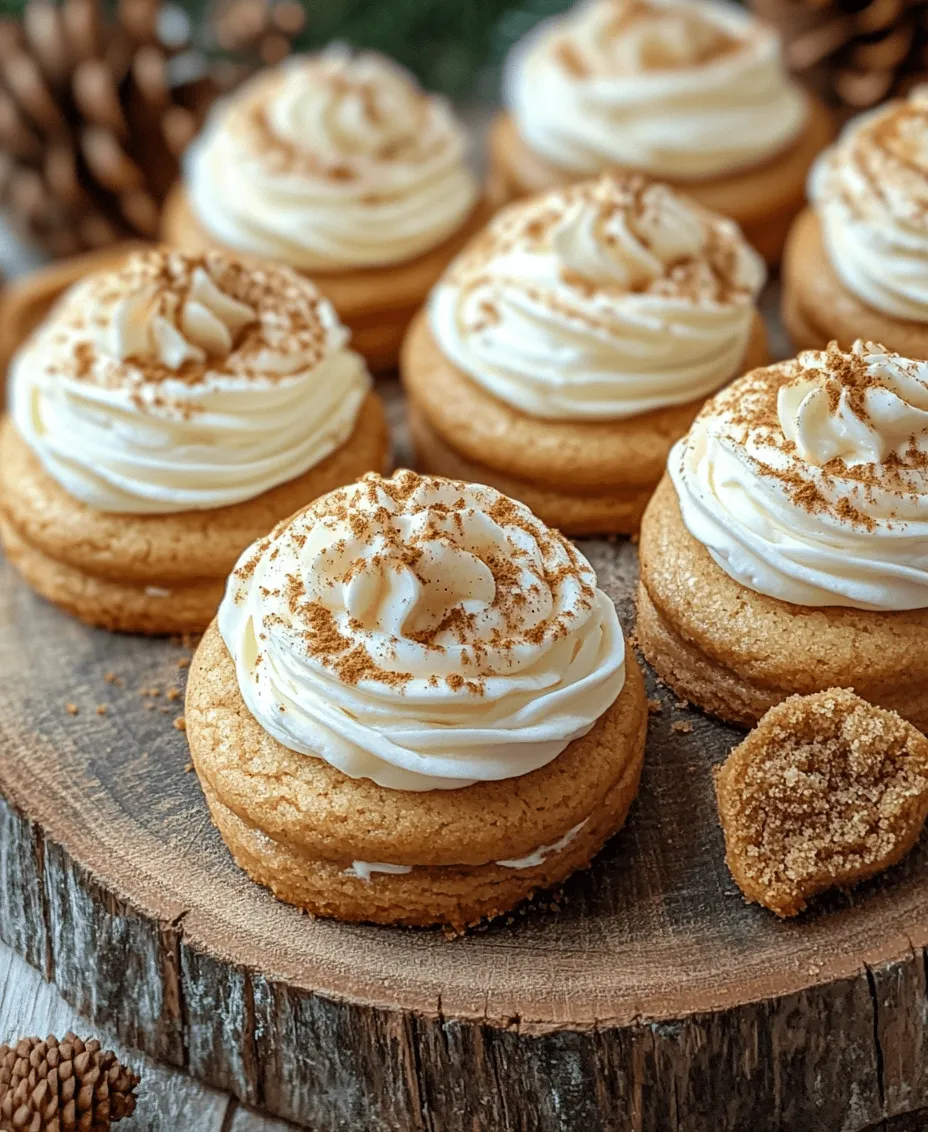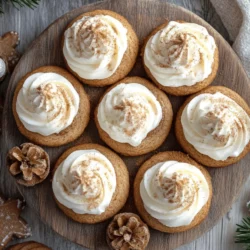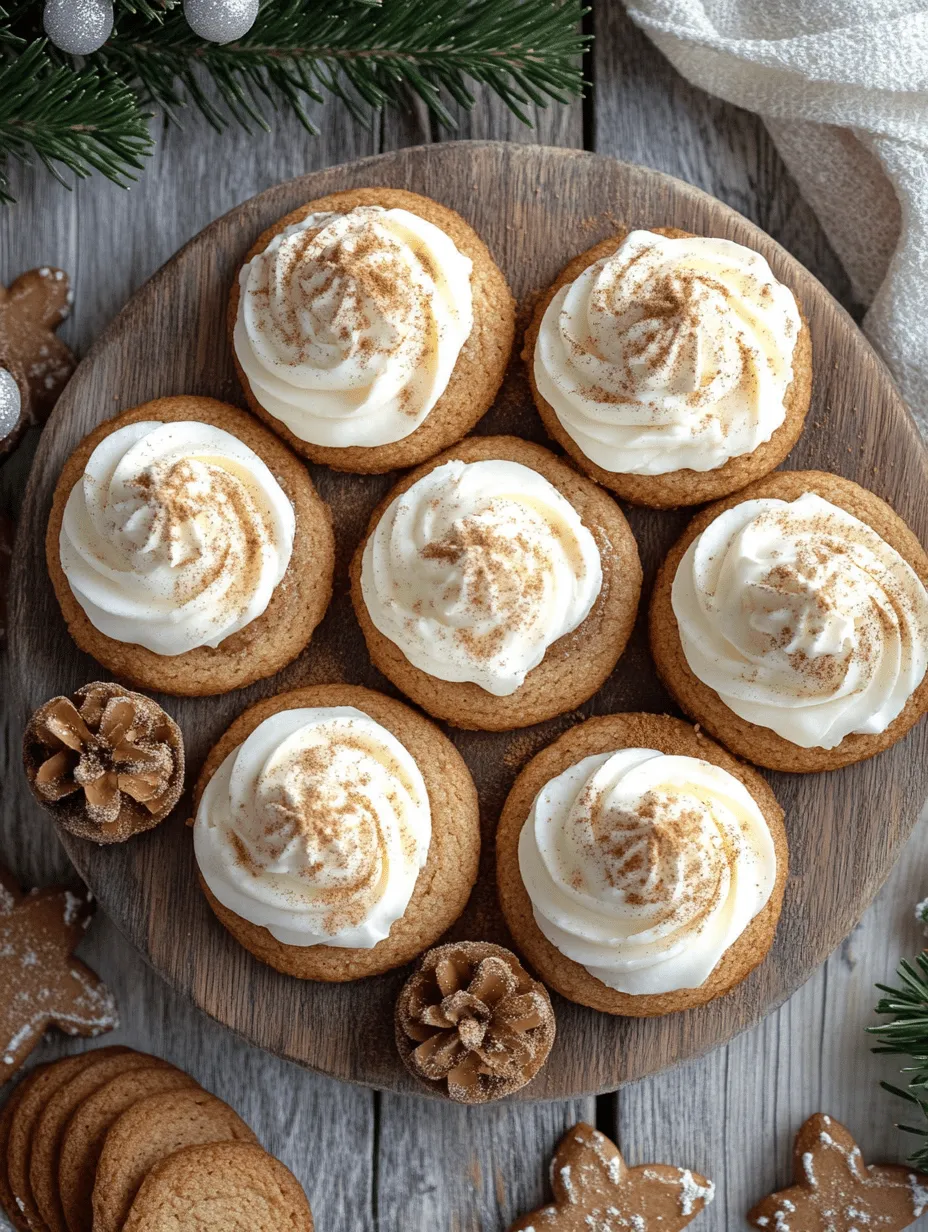As the holiday season approaches, the air fills with a sense of joy and festivity. Families gather to celebrate traditions, share stories, and of course, indulge in delicious baked goods. The warmth of freshly baked treats wafts through homes, evoking memories of childhood and the magic of winter holidays. In this spirit of celebration, we are excited to introduce a decadent dessert that beautifully marries the rich flavors of traditional gingerbread with the creamy goodness of cheesecake: Gingerbread Cheesecake Cookies.
These cookies are not just another holiday treat; they are a delightful fusion that encapsulates the essence of the season. Imagine biting into a soft, spiced gingerbread cookie, only to discover a luscious cheesecake filling that melts in your mouth. This perfect combination of textures and flavors makes Gingerbread Cheesecake Cookies an ideal addition to your holiday gatherings, family celebrations, or even as a thoughtful gift for loved ones. Whether you’re hosting a holiday party or simply looking for a sweet treat to enjoy by the fire, these cookies are sure to impress and delight.
Understanding the Ingredients
Creating the perfect Gingerbread Cheesecake Cookies begins with understanding the key ingredients that contribute to their unique flavor and texture. Each component plays a crucial role in crafting this delicious dessert, and knowing their functions will help you achieve the best results.
All-Purpose Flour
All-purpose flour is the backbone of any cookie recipe, providing the structure and stability needed to hold the cookie together. It is essential for creating the right texture; too much flour can result in dry cookies, while too little can make them overly soft and crumbly. For our Gingerbread Cheesecake Cookies, the balance is key, ensuring that each cookie maintains a delightful chewiness while still being sturdy enough to hold the sumptuous cheesecake filling.
Spices: Ginger, Cinnamon, Nutmeg, and Cloves
The aromatic spices—ginger, cinnamon, nutmeg, and cloves—are what give gingerbread its distinctive flavor profile. Ginger brings a warm heat and a hint of sweetness, while cinnamon adds an earthy warmth that is comforting and familiar. Nutmeg contributes a slightly sweet and nutty flavor, enhancing the overall depth of the cookie. Finally, cloves impart a fragrant spiciness that rounds out the blend. Together, these spices create a delightful symphony of flavors that evoke the very essence of the holiday season.
Unsalted Butter and Sugars
Unsalted butter is a crucial ingredient in baking, providing richness and moisture to the cookies. The type of sugars used also plays a significant role in the final texture and sweetness. Brown sugar, with its higher moisture content, contributes to a chewier cookie and adds a hint of caramel flavor. Granulated sugar, on the other hand, promotes crispness. The combination of these sugars with butter is vital for achieving the perfect balance of sweetness and texture in our Gingerbread Cheesecake Cookies.
Molasses
Molasses is a key ingredient in traditional gingerbread recipes, imparting a deep, robust flavor and a rich brown color to the cookies. Its unique sweetness complements the spices and adds moisture, preventing the cookies from becoming dry. Additionally, molasses enhances the overall flavor complexity, making each bite a delightful journey of taste.
Cream Cheese
The star of the show is undoubtedly the cream cheese, which forms the creamy cheesecake filling. Its rich, tangy flavor provides a beautiful contrast to the spiced cookie, while its smooth texture creates a luxurious mouthfeel. Using room temperature cream cheese is essential; it allows for a seamless mixing process, ensuring a lump-free filling that pairs perfectly with the gingerbread exterior.
Step-by-Step Guide to Making Gingerbread Cheesecake Cookies
Now that we’ve discussed the essential ingredients, let’s dive into the process of making these delightful cookies. Follow this step-by-step guide to create Gingerbread Cheesecake Cookies that will surely become a holiday favorite.
Preparation of Cookie Dough
1. Mixing the Dry Ingredients: Begin by sifting together the all-purpose flour, baking soda, and spices in a mixing bowl. Sifting is crucial as it aerates the flour, ensuring a light and fluffy texture. This step also helps distribute the spices evenly throughout the flour, preventing clumps and ensuring that every bite is packed with flavor.
2. Creaming Butter and Sugars: In a separate large mixing bowl, beat the unsalted butter and sugars together until the mixture is light and fluffy. This process, known as creaming, is vital for incorporating air into the dough, which helps the cookies rise during baking. Aim for a consistency that is smooth and pale, indicating that enough air has been incorporated.
3. Incorporating the Wet Ingredients: Gradually add in the molasses and a beaten egg to the butter-sugar mixture, mixing until fully combined. The molasses not only adds flavor but also contributes to the moisture of the dough, resulting in soft cookies.
4. Combining Dry and Wet Ingredients: Slowly add the dry mixture to the wet ingredients, mixing just until combined. Be careful not to overmix, as this can result in dense cookies. The dough should be slightly sticky but manageable.
Chilling the Dough
Chilling the cookie dough is a crucial step that should not be overlooked. This process allows the fats in the butter to solidify, which helps the cookies maintain their shape during baking. Additionally, chilling the dough enhances the flavors as the ingredients meld together, resulting in a more robust taste. Wrap the dough in plastic wrap and refrigerate it for at least 30 minutes, or up to overnight for best results.
Creating the Cheesecake Filling
While the cookie dough is chilling, it’s time to prepare the cheesecake filling. The filling is what makes these cookies truly special, and achieving the right consistency is essential.
1. Mixing the Cream Cheese: In a mixing bowl, beat the room temperature cream cheese until it’s smooth and creamy. This step is crucial; starting with cold cream cheese can lead to lumps in the filling, so ensure it’s at room temperature for optimal mixing.
2. Adding Sugar and Vanilla: Gradually add granulated sugar and a splash of vanilla extract to the cream cheese, mixing until well combined. The sugar will sweeten the filling, while the vanilla adds depth and warmth.
3. Incorporating an Egg: Finally, add in one egg and mix until the filling is completely smooth. The egg helps to bind the filling together and gives it a creamy, custard-like texture.
With the cookie dough chilled and the cheesecake filling prepared, you are now ready to assemble your Gingerbread Cheesecake Cookies. In the next section, we will guide you through the final steps of shaping, baking, and enjoying these festive delights.

Shaping and Filling the Cookies
Once your dough has chilled and is firm to the touch, it’s time to shape and fill your Gingerbread Cheesecake Cookies. This step requires a bit of finesse to ensure you achieve uniform cookie balls and perfect indentations for the filling.
Rolling the Dough: Techniques for Uniform Cookie Balls
Start by preheating your oven to 350°F (175°C) if you haven’t already. Prepare a baking sheet lined with parchment paper to prevent sticking. Use a cookie scoop or a tablespoon to take equal amounts of dough, ensuring each cookie is the same size for even baking. Roll the dough into smooth balls between your palms. The warmth from your hands will help the dough become more pliable, making it easier to shape.
A helpful tip is to lightly flour your hands if the dough is too sticky. This will prevent it from adhering to your fingers, allowing for easier shaping. Aim for about 1 inch in diameter for each cookie ball; this size will provide the right balance between cookie and cheesecake filling.
Making the Perfect Indentation for Filling
With your cookie balls formed, it’s time to create the perfect indentation for the cheesecake filling. Using your thumb or the back of a measuring teaspoon, gently press down the center of each cookie ball. Be careful not to press too hard; you want to create a well without compromising the cookie’s shape. The indentation should be deep enough to hold the filling but shallow enough to maintain the structural integrity of the cookie.
After shaping and indenting all the cookie balls, place them on the prepared baking sheet. Leave enough space between each cookie to allow them to spread while baking, about 2 inches apart.
Baking the Cookies
Understanding the Baking Process
Baking is where the magic happens! Place the baking sheet in the preheated oven and bake the cookies for about 10-12 minutes. The edges should look set while the centers may appear slightly underbaked. This is ideal, as the cookies will continue to firm up as they cool.
Keep a close eye on them during the last few minutes of baking. If you notice the edges starting to turn golden brown, it’s a sign they are done. Remember, every oven can vary, so checking a minute or two before the suggested time is always a good idea.
Importance of Cooling Before Serving
Once baked, remove the cookies from the oven and allow them to cool on the baking sheet for about 5 minutes. This cooling period is crucial, as it helps the cookies set properly. Afterward, transfer them to a wire rack to cool completely. Cooling not only affects the texture but also helps the flavors meld together beautifully. When served warm, the cheesecakes will be creamy, while fully cooled cookies offer a delightful texture that balances soft and chewy.
Serving Suggestions and Variations
Garnishing Ideas
Now that your Gingerbread Cheesecake Cookies are baked and cooled, it’s time to serve them up! For a festive touch, consider garnishing them with a dollop of whipped cream on top. This adds an airy texture that complements the rich cheesecake filling beautifully. To elevate the presentation, sprinkle crushed gingersnap cookies over the whipped cream for an extra burst of flavor and crunch.
If you’re feeling adventurous, drizzle some melted chocolate or caramel sauce on top for added decadence. These little touches not only enhance the flavor but also make your cookies visually appealing for any holiday gathering.
Variations on the Recipe
One of the joys of baking is the ability to customize recipes to suit your taste. Here are a few variations to consider for your Gingerbread Cheesecake Cookies:
– Spice Adjustments: If you want to shake things up, feel free to alter the spices in the dough. Adding a dash of nutmeg or cardamom can introduce a unique flavor profile that pairs well with the ginger.
– Chocolate Twist: For chocolate lovers, consider folding in some mini chocolate chips into the cheesecake filling. This will create a delightful contrast with the gingerbread base.
– Dietary Adaptations: If you have dietary restrictions, don’t worry! These cookies can easily be made gluten-free by substituting regular flour with a gluten-free blend. For a dairy-free version, use vegan cream cheese and coconut cream for the filling, ensuring everyone can enjoy these delicious treats.
The Joy of Baking During the Holidays
Baking during the holiday season is more than just a culinary task; it’s an emotional experience that brings joy and warmth to families and friends. The act of creating something from scratch, especially something as delightful as Gingerbread Cheesecake Cookies, fosters a sense of togetherness.
Gathering in the kitchen to bake can lead to cherished memories—whether it’s rolling dough, decorating cookies, or simply enjoying the sweet aroma wafting through the house. Baking not only fills your home with delightful scents but also provides an opportunity to connect with loved ones. Sharing these cookies with family and friends becomes a wonderful way to spread joy and create lasting memories.
As a famous saying goes, “Food is the ingredient that binds us together.” So, gather your family around, share stories, and enjoy the process of creating these festive treats together.
Storage and Freshness Tips
To keep your Gingerbread Cheesecake Cookies fresh and delicious, proper storage is essential. Once the cookies have cooled completely, you can store them in an airtight container at room temperature for up to five days. If you’re looking to enjoy them later, freezing is a fantastic option.
Freezing for Future Enjoyment
To freeze your cookies, first, ensure they are completely cooled. Place them in a single layer on a baking sheet and freeze until solid. Once frozen, transfer the cookies to a freezer-safe container or a zip-top bag, separating layers with parchment paper to prevent sticking. Properly stored, they can last for up to three months in the freezer.
When you’re ready to enjoy them, simply remove the desired number of cookies and let them thaw at room temperature. For an added treat, consider warming them in the oven for a few minutes to refresh their texture.
Conclusion
Gingerbread Cheesecake Cookies are not just a delightful combination of flavors; they embody the spirit of the holiday season. With their festive aroma and rich, creamy filling, they are sure to become a beloved addition to your holiday baking repertoire.
Whether you’re baking alone or with loved ones, this recipe encourages creativity and togetherness. So, gather your ingredients, embrace the joy of baking, and create these delicious cookies that are perfect for sharing. Celebrate the season, make lasting memories, and enjoy the sweet rewards of your hard work. Happy baking!

